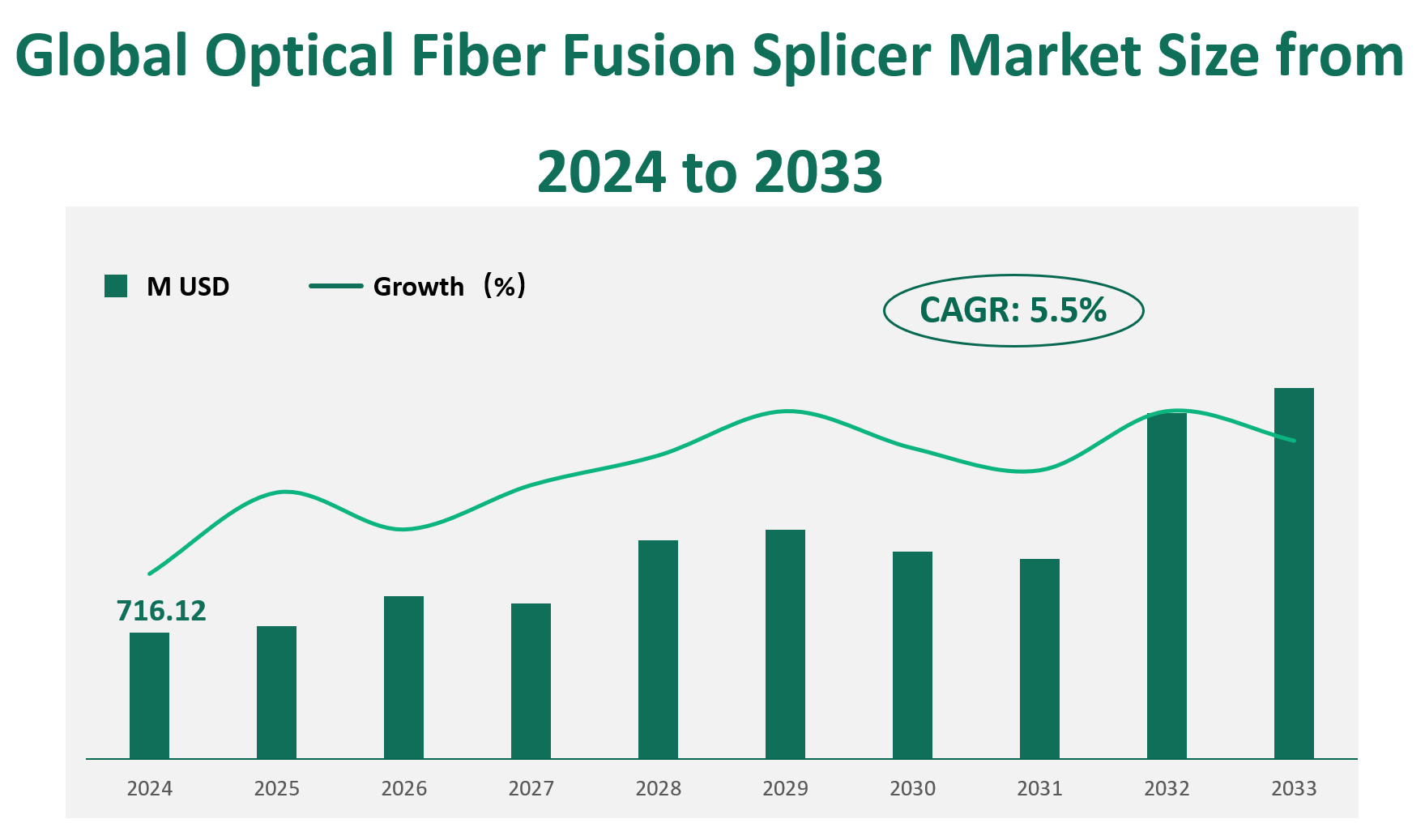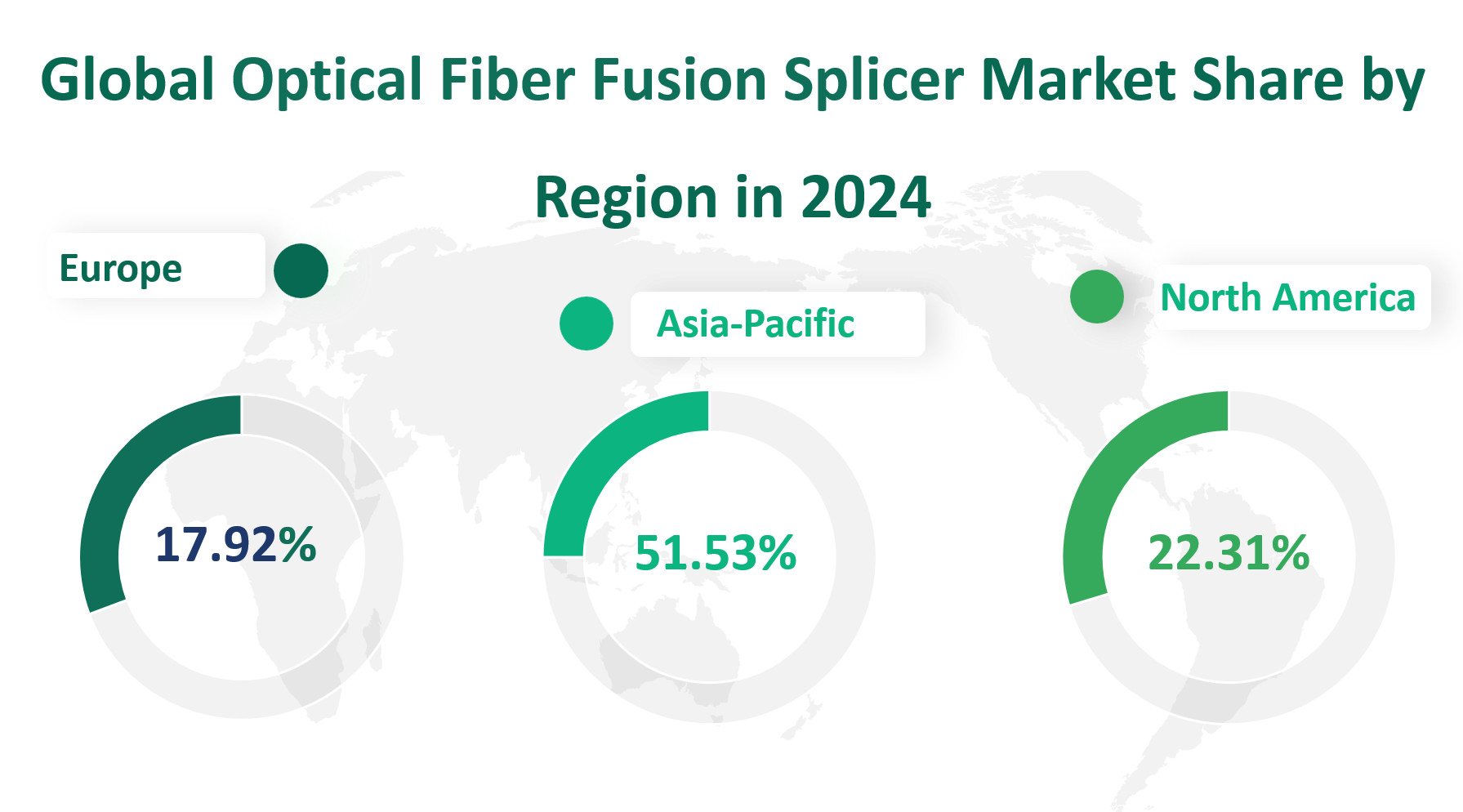1. Global Optical Fiber Fusion Splicer Market Insight Analysis
The global Optical Fiber Fusion Splicer market is projected to reach a revenue of 716.12 million USD in 2024, with a Compound Annual Growth Rate (CAGR) of approximately 5.5% from 2024 to 2033.
An Optical Fiber Fusion Splicer is a high-precision device used to connect two optical fibers by melting their ends together using heat. This process, known as fusion splicing, ensures minimal signal loss and high reliability, making it essential for modern optical communication networks. The device integrates advanced technologies, including optics, electronics, and software, to achieve precise alignment and fusion of fiber cores. Fusion splicers are widely used in the construction and maintenance of fiber optic networks, including FTTH (Fiber to the Home), data centers, and long-haul telecommunications infrastructure. They are also crucial for applications in military, premises, and enterprise networks, where high data transmission rates and reliability are paramount.
Figure Global Optical Fiber Fusion Splicer Market Size (M USD) and CAGR (2024-2033)

2. Driving and Limiting Factors of Optical Fiber Fusion Splicer Market Growth
The growth of the Optical Fiber Fusion Splicer market is driven by several key factors. Firstly, the increasing demand for high-speed broadband and improved network infrastructure is a major driver. Governments worldwide are investing heavily in broadband expansion projects to meet the growing needs of digital economies. For example, the United States has allocated significant funds for rural broadband deployment, while countries like Brazil and India are implementing national broadband plans to enhance connectivity.
The surge in FTTH deployments is another significant driver, as it requires extensive use of fiber optic cables and splicing equipment. The COVID-19 pandemic has further accelerated this trend, as more people rely on home internet for work, education, and entertainment, increasing the demand for robust fiber optic networks.
However, the market also faces several limiting factors. One of the primary challenges is the high technical barrier to entry. Optical fiber fusion splicers require advanced precision engineering and integration of multiple technologies, including optics, electronics, and software. This complexity makes it difficult for new players to enter the market and compete with established players.
Additionally, the market is highly dependent on the availability of raw materials and components, which can be affected by global supply chain disruptions. The COVID-19 pandemic has highlighted these vulnerabilities, causing delays in production and increased costs for manufacturers.
3. Technology Innovation and Corporate Mergers and Acquisitions in Optical Fiber Fusion Splicer Market
Technological innovation is a key driver of the Optical Fiber Fusion Splicer market. Modern splicers are equipped with advanced features such as real-time fiber condition analysis, automated alignment, and cloud connectivity for remote monitoring and data management. For example, Fujikura’s 90S+ splicer incorporates “Active Fusion Control Technology” to maintain consistent low-loss splicing results. Similarly, Sumitomo Electric’s TYPE-72C+ features AI-programmed core alignment, enhancing precision and reliability. These advancements not only improve the performance of splicers but also reduce operational costs and increase efficiency.
Corporate mergers and acquisitions are also shaping the market landscape. Major players are continuously seeking opportunities to expand their product portfolios and enhance their market positions. For instance, Jilong Optical Communication’s strategic cooperation with Dawa Tools aims to innovate and expand their presence in the optical communications field. Such collaborations and acquisitions help companies leverage complementary technologies and resources, driving further growth and innovation in the market.
4. Global Optical Fiber Fusion Splicer Market Size by Type
Optical Fiber Fusion Splicers are categorized into three main types: Single Fiber Fusion Splicer, Ribbon Fiber Fusion Splicer, and Special Fiber Fusion Splicer.
The Single Fiber Fusion Splicer is the most common type, designed for splicing individual optical fibers. It is widely used in various applications, including telecommunications, CATV (Community Antenna Television), and enterprise networks. This type of splicer is known for its precision and reliability, making it a preferred choice for critical fiber optic connections. In 2024, the global market revenue for Single Fiber Fusion Splicers is projected to reach $523.9 million. This type holds the largest market share, accounting for approximately 73.16% of the total market revenue. The dominance of Single Fiber Fusion Splicers can be attributed to their versatility and widespread use in both new installations and maintenance of fiber optic networks.
Ribbon Fiber Fusion Splicers are designed to splice multiple fibers simultaneously, significantly increasing efficiency in large-scale installations. These splicers are particularly useful in applications where multiple fibers need to be connected quickly, such as in data centers and high-capacity telecommunications networks. In 2024, the global market revenue for Ribbon Fiber Fusion Splicers is expected to be $156.9 million, representing a market share of 21.91%. While they have a smaller market share compared to Single Fiber Fusion Splicers, Ribbon Fiber Fusion Splicers are gaining traction due to the increasing demand for high-capacity fiber optic networks.
Special Fiber Fusion Splicers are designed for unique applications that require specialized splicing techniques. These splicers are used in industries such as aerospace, military, and medical, where standard splicing methods may not suffice. The global market revenue for Special Fiber Fusion Splicers in 2024 is projected to be $35.3 million, with a market share of 4.93%. Although this type has the smallest market share, it plays a crucial role in niche applications where precision and reliability are paramount.
Table Global Optical Fiber Fusion Splicer Market Size by Type in 2024
Market Size (M USD) 2024 | Market Share | |
Single fiber fusion splicer | 523.90 | 73.16% |
Ribbon fiber fusion splicer | 156.91 | 21.91% |
Special fiber fusion splicer | 35.30 | 4.93% |
5. Global Optical Fiber Fusion Splicer Market Size by Application
The Optical Fiber Fusion Splicer market serves a variety of applications, each with distinct requirements and market dynamics. The primary applications include Telecommunications, CATV, Premises & Enterprise, Military, and Others.
The Telecommunications sector is the largest application area for Optical Fiber Fusion Splicers. This industry relies heavily on fiber optic networks for data transmission, voice communication, and internet services. The demand for high-speed, reliable communication networks drives the need for advanced splicing technologies. In 2024, the global market revenue for Optical Fiber Fusion Splicers in the Telecommunications sector is projected to be $394.17 million, accounting for 55.04% of the total market revenue. The growth in this sector is driven by the expansion of 5G networks and the increasing demand for broadband services.
CATV networks use Optical Fiber Fusion Splicers to connect fiber optic cables that deliver television signals to homes and businesses. The demand for high-definition and ultra-high-definition content has increased the need for reliable and efficient splicing solutions. In 2024, the global market revenue for Optical Fiber Fusion Splicers in the CATV sector is expected to be $121.01 million, representing a market share of 16.90%. The growth in this sector is driven by the increasing demand for high-quality video content and the expansion of fiber-to-the-home (FTTH) networks.
Premises & Enterprise includes the installation and maintenance of fiber optic networks within buildings and enterprises. These networks support internal communication systems, data centers, and other critical infrastructure. In 2024, the global market revenue for Optical Fiber Fusion Splicers in the Premises & Enterprise sector is projected to be $121.34 million, with a market share of 16.94%. The growth in this sector is driven by the increasing demand for high-speed internal networks and the need for reliable data transmission within enterprises.
The Military sector uses Optical Fiber Fusion Splicers for secure communication networks, surveillance systems, and other critical applications. The demand for reliable and secure fiber optic connections drives the need for advanced splicing technologies. In 2024, the global market revenue for Optical Fiber Fusion Splicers in the Military sector is expected to be $30.72 million, representing a market share of 4.29%. The growth in this sector is driven by the increasing demand for secure communication systems and the need for reliable fiber optic networks in military operations.
Table Global Optical Fiber Fusion Splicer Market Size by Application in 2024
Application | Market Size (M USD) 2024 | Market Share |
CATV | 121.01 | 16.90% |
Telecom | 394.17 | 55.04% |
Premises& Enterprise | 121.34 | 16.94% |
Military | 30.72 | 4.29% |
Others | 48.89 | 6.83% |
6. Global Optical Fiber Fusion Splicer Market by Top Regions
North America is projected to generate a revenue of $159.78 million USD in 2024. The region’s market is driven by robust demand from the telecommunications and CATV sectors, supported by continuous investments in broadband infrastructure. The United States, in particular, is a key market, with significant contributions from companies like Fujikura and UCL Swift. The region’s growth is also bolstered by technological advancements and high disposable incomes, which drive the adoption of advanced fiber optic solutions.
Europe is expected to contribute $128.31 million USD to the global market in 2024. The European market is characterized by strong demand from the telecom and CATV sectors, particularly in countries like Germany, the UK, and France. The region’s growth is supported by government initiatives to expand broadband networks and improve digital infrastructure. European companies such as Sumitomo Electric and INNO Instrument play a significant role in driving technological innovation and market expansion.
Asia-Pacific is the largest regional market by revenue, projected to reach $369.00 million USD in 2024. The region’s dominance is attributed to rapid technological advancements, increasing demand for high-speed internet, and extensive fiber optic network deployments in countries like China, Japan, and South Korea. China, in particular, is a major market, accounting for a significant share of the region’s revenue. The growth is further driven by government initiatives to expand broadband access and improve network reliability. Key players in the region, such as Fujikura and Furukawa, are continuously investing in R&D to enhance product offerings and meet the growing demand.
South America is expected to generate a revenue of $29.39 million USD in 2024. The region’s market is driven by increasing demand for fiber optic networks in countries like Brazil and Argentina.
Middle East and Africa is projected to contribute $29.64 million USD in 2024. The region’s market is driven by increasing demand for fiber optic networks in countries like the UAE and South Africa.
Figure Global Optical Fiber Fusion Splicer Market Size by Region in 2024

7. Global Optical Fiber Fusion Splicer Market Analysis by Major Players
7.1 Fujikura
Company Introduction and Business Overview: Fujikura is a leading manufacturer of optical fiber fusion splicers, with a strong presence in the global market. Established in 1910, the company is headquartered in Tokyo, Japan. Fujikura is renowned for its high-quality and reliable fusion splicers, which are widely used in telecommunications, CATV, and other fiber optic applications.
Products Offered: Fujikura offers a range of fusion splicers, including the 90S+ and 41S+ models. These splicers are equipped with advanced features such as active fusion control, real-time fiber condition analysis, and automated alignment, ensuring high precision and reliability.
7.2 Furukawa
Company Introduction and Business Overview: Furukawa is a major player in the optical fiber fusion splicer market, with a strong presence in Japan and other global regions. Established in 1896, the company is headquartered in Tokyo, Japan. Furukawa offers a wide range of optical communication products and solutions, including fusion splicers, optical fibers, and related tools.
Products Offered: Furukawa’s product portfolio includes the S124M4 ribbon fusion splicer, which is known for its high-speed splicing and heating capabilities. The company also offers single fiber fusion splicers with advanced features such as automated fiber alignment and real-time monitoring.
7.3 Sumitomo Electric
Company Introduction and Business Overview: Sumitomo Electric is a leading manufacturer of electronic components and optical communication solutions. Established in 1897, the company is headquartered in Osaka, Japan. Sumitomo Electric is known for its advanced fusion splicer technologies and global service network.
Products Offered: Sumitomo Electric’s product offerings include the TYPE-72C+ fusion splicer, which features AI-programmed core alignment and high-definition imaging. The company also offers a range of optical communication tools and accessories.

